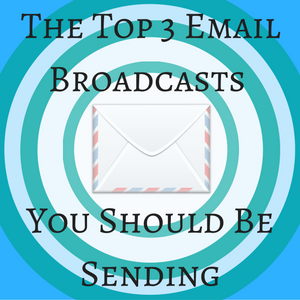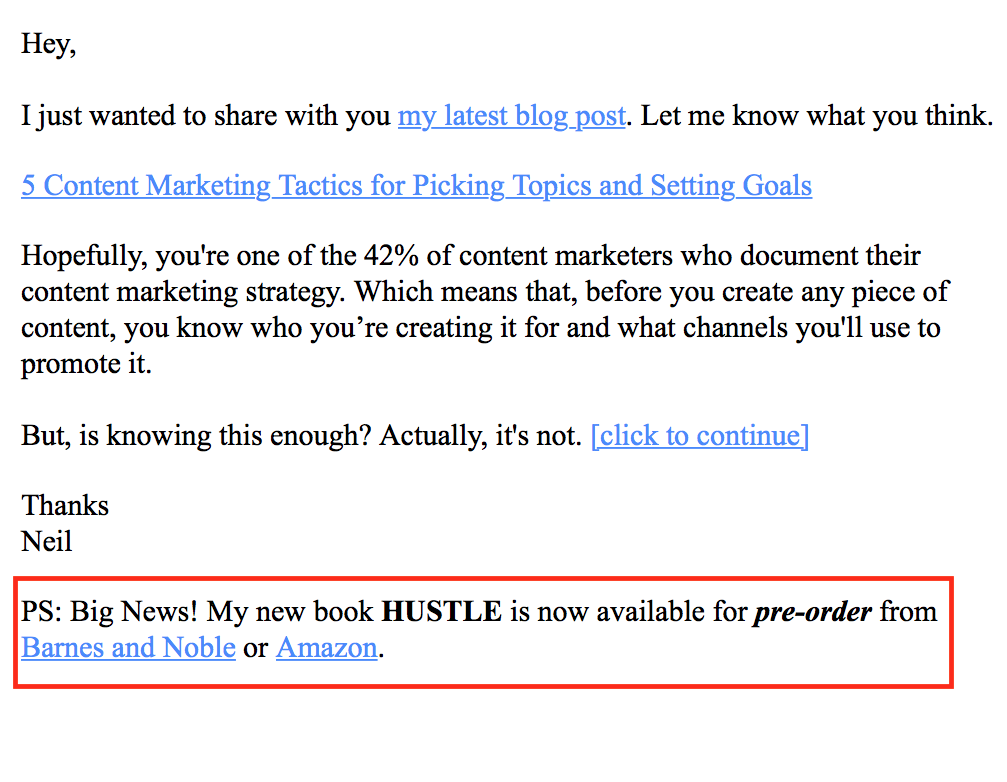
Email marketing produces a higher ROI than any other form of online marketing. Most marketers’ biggest regret is not building an email list sooner. Email marketing is that valuable.
There are plenty of ways to get more people to sign up for your email list. Landing pages and pop-up messages are two of the many methods I discuss in this post.
But what happens once someone subscribes and goes through your autoresponder? What email broadcasts are these people getting on a daily or weekly basis?
Over 100 billion emails are sent each day. These emails have many different lengths and purposes. Some are from friends or co-worker, while others pitch products and services.
It’s easy to become overwhelmed by the options, but these are the top three email broadcasts you should be sending your subscribers:
#1: Community Broadcast
The Community Broadcast asks readers to participate in a particular activity, from a real event to answering a question or providing a simple observation.
Most email broadcasts don’t involve community action. Rather, they often contain a CTA asking the reader to clink on a link or make a purchase. While those emails are important, the Community Broadcast is less about promotion and more about building relationships.
A while ago, I sent a community broadcast inviting my audience to ask me questions that I could answer on my YouTube Q&A series. The result? I got dozens of replies and enjoyed huge growth on my YouTube channel.
I like to get my community involved with the creation process. Not only do I get new ideas, but I’m also serving them better by showing an interest in what really matters to them. The questions they ask are always based on the problems they face each day. And since many of those issues are shared by a large segment of my audience, the videos appeal to most of my subscribers.
Find Inspiration
The questions themselves inspire new ideas for content. For example, one person asked me how he could get more book sales. Once I knew that question resonated with my audience, I dedicated an entire video to the topic.
Content producers always aim to inform, entertain or empower their audience. Every time I respond to questions, I know I am empowering my audience. And when my content empowers people, I know I’ve done a good job.
The possibilities for Community Broadcasts are endless. Community Broadcasts involve anything that will get your community involved. In addition to asking questions, you can encourage networking and dialog among your audience by creating a Facebook Group and inviting them to join. Or you can create a 30 day challenge of some sort and ask participants to share their results.
Remember that Community Broadcasts are more potent when your focus is on the love for your community rather than how you or your business will benefit.
#2: Broadcast Of Value
The Broadcast Of Value is an email broadcast in which you provide free value in the form of a blog post, YouTube video, podcast, livestream, webinar, or any other means.
These email broadcasts help you build credibility because people will associate your name with valuable information that is relevant to their interests. And as you become more credible, they will be more inclined to share your content.
The cool thing about the Broadcast Of Value is that you can turbocharge certain parts of your business. If you start a new podcast and have 10,000 email subscribers, you can easily tell those people about your first episode.
Hopefully they will tune in to your podcast or download the episode. As your episodes receive more downloads, your podcasts will rank higher and possibly end up in the New & Noteworthy category (the gold mine category for new podcasts on iTunes).
Segmenting
I have two rules for sending Broadcasts Of Value: the first is to provide value, and the second is to segment my lists as much as possible.
For example, when people subscribe to receive my “27 Ways To Get More Retweets On Twitter” eBook, they are automatically added to my Twitter email list. This helps me on the weeks I produce a lot of content because I can be more selective about who receives what content.
For example, I may send different email broadcasts to segmented lists. The people on my Twitter email list might receive a Twitter How-To post while the people who’ve subscribed to my blog will receive a How-To Blog post.
Segmenting your email lists, and then sending targeted email broadcasts to each list, results in more engagement and fewer unsubscribes because you are aligning your content with audience interests.
The people on my Twitter list definitely want to learn more about Twitter. Otherwise, they wouldn’t have requested my free Twitter eBook. Some of them are also interested in blogging, but since I can’t be sure, I do not want to risk sending them irrelevant content. Likewise, the people who’ve downloaded by eBook “27 Simple Ways To Get More Blog Subscribers” are sent more blog-related content.
#3: Product Broadcast
The moment you’ve all been waiting for. The email list is the most profitable online platform today. But to make a profit you need to sell stuff. There’s no way around it.
I’ve read many Product Broadcasts and I can assure you that not all sales pitches are created equal. Most will lose your attention right away, some will leave you interested, and a few will prompt you to take immediate action.
Plus, if you send Product Broadcasts too often people will not want to hear from you anymore. No matter how strong your reputation, promoting product after product without sending other types of email broadcasts will hurt your credibility.
As a general rule, you should only send Product Broadcasts every 2-3 months. For a product launch, however, some companies send as many as 20 emails. These types of email campaigns are okay as long as you offer something of free value and make sure they don’t last for more than a month.
Be Subtle
It’s also important to be subtle when it comes to product promotion. What exactly does that mean?
For other types of email broadcasts, you can sneak in a product promotion. Two people who do this well are Neil Patel and Jeff Goins. Leading up to the launch of his book Hustle, Neil included a subtle call-to-action to preorder the book.

This isn’t an in-your-face CTA. It’s not an email discussing all of the benefits of the book. It’s permission marketing in full effect. Neil isn’t telling you to buy his book. He’s just letting you know that it’s out there.
Jeff Goins is another person who knows how to subtly promote a product, service, or in this case, an event. During the Self-Publishing Success Summit, Jeff integrated event promotion with his latest content.

That changes the entire dynamic of the email. Instead of primarily talking about SPSS, Jeff sprinkled it on top of another type of email broadcast.
Being subtle does not mean tricking your audience into doing something. It simply means focusing the main message of your email broadcast on one thing and gently mentioning a useful product, service, or event towards the end of the email broadcast.
In Conclusion
Email marketing trumps all other forms of marketing. It can even be argued that the primary purpose of other types of digital marketing is to attract more people to your email lists. If you make that part of all of your marketing efforts, your email broadcast will get more engagement.
And that added engagement will result in more traffic and sales.
What are your thoughts on these three types of email broadcasts? Which one of do you send most often? Do you send a different type of email broadcast? Sound off in the comments section below.

VERY GOOD CONTENT
Thank you Davide 🙂